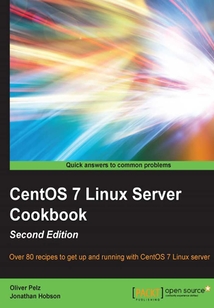目錄(136章)
倒序
- 封面
- 版權頁
- Credits
- About the Authors
- About the Reviewer
- www.PacktPub.com
- Support files eBooks discount offers and more
- Preface
- What this book covers
- What you need for this book
- Who this book is for
- Sections
- Conventions
- Reader feedback
- Customer support
- Chapter 1. Installing CentOS
- Introduction
- Downloading CentOS and confirming the checksum on Windows or OS X
- Creating USB installation media on Windows or OS X
- Performing an installation of CentOS using the graphical installer
- Running a netinstall over HTTP
- Installing CentOS 7 using a kickstart file
- Getting started and customising the boot loader
- Troubleshooting the system in rescue mode
- Updating the installation and enhancing the minimal install with additional administration and development tools
- Chapter 2. Configuring the System
- Introduction
- Navigating text files with less
- Introduction to Vim
- Speaking the right language
- Synchronizing the system clock with NTP and the chrony suite
- Setting your hostname and resolving the network
- Building a static network connection
- Becoming a superuser
- Customizing your system banners and messages
- Priming the kernel
- Chapter 3. Managing the System
- Introduction
- Knowing and managing your background services
- Troubleshooting background services
- Tracking system resources with journald
- Configuring journald to make it persistent
- Managing users and their groups
- Scheduling tasks with cron
- Synchronizing files and doing more with rsync
- Maintaining backups and taking snapshots
- Monitoring important server infrastructure
- Taking control with GIT and Subversion
- Chapter 4. Managing Packages with YUM
- Introduction
- Using YUM to update the system
- Using YUM to search for packages
- Using YUM to install packages
- Using YUM to remove packages
- Keeping YUM clean and tidy
- Knowing your priorities
- Using a third-party repository
- Creating a YUM repository
- Working with the RPM package manager
- Chapter 5. Administering the Filesystem
- Introduction
- Creating a virtual block device
- Formatting and mounting a filesystem
- Using disk quotas
- Maintaining a filesystem
- Extending the capacity of the filesystem
- Chapter 6. Providing Security
- Introduction
- Locking down remote access and hardening SSH
- Installing and configuring fail2ban
- Working with a firewall
- Forging the firewall rules by example
- Generating self-signed certificates
- Using secure alternatives to FTP
- Chapter 7. Building a Network
- Introduction
- Printing with CUPS
- Running a DHCP server
- Using WebDAV for file sharing
- Installing and configuring NFS
- Working with NFS
- Securely sharing resources with Samba
- Chapter 8. Working with FTP
- Introduction
- Installing and configuring the FTP service
- Working with virtual FTP users
- Customizing the FTP service
- Troubleshooting users and file transfers
- Chapter 9. Working with Domains
- Introduction
- Installing and configuring a caching-only nameserver
- Setting up an authoritative-only DNS server
- Creating an integrated nameserver solution
- Populating the domain
- Building a secondary (slave) DNS server
- Chapter 10. Working with Databases
- Introduction
- Installing a MariaDB database server
- Managing a MariaDB database
- Allowing remote access to a MariaDB server
- Installing a PostgreSQL server and managing a database
- Configuring remote access to PostgreSQL
- Installing phpMyAdmin and phpPgAdmin
- Chapter 11. Providing Mail Services
- Introduction
- Configuring a domain-wide mail service with Postfix
- Working with Postfix
- Delivering the mail with Dovecot
- Using Fetchmail
- Chapter 12. Providing Web Services
- Introduction
- Installing Apache and serving web pages
- Enabling system users and building publishing directories
- Implementing name-based hosting
- Implementing CGI with Perl and Ruby
- Installing configuring and testing PHP
- Securing Apache
- Setting up HTTPS with Secure Sockets Layer (SSL)
- Chapter 13. Operating System-Level Virtualization
- Introduction
- Installing and configuring Docker
- Downloading an image and running a container
- Creating your own images from Dockerfiles and uploading to Docker Hub
- Setting up and working with a private Docker registry
- Chapter 14. Working with SELinux
- Introduction
- Installing and configuring important SELinux tools
- Working with SELinux security contexts
- Working with policies
- Troubleshooting SELinux
- Chapter 15. Monitoring IT Infrastructure
- Introduction
- Installing and configuring Nagios Core
- Setting up NRPE on remote client hosts
- Monitoring important remote system metrics
- Index 更新時間:2021-07-23 14:29:12
推薦閱讀
- 軟件項目估算
- 劍指JVM:虛擬機實踐與性能調優
- 數據結構(C語言)
- Learning Apache Kafka(Second Edition)
- Learning Three.js:The JavaScript 3D Library for WebGL
- Java EE 8 Application Development
- Spring快速入門
- Android系統原理及開發要點詳解
- D3.js By Example
- Mastering ArcGIS Enterprise Administration
- Oracle GoldenGate 12c Implementer's Guide
- Python3.5從零開始學
- 移動互聯網軟件開發實驗指導
- PHP 7從零基礎到項目實戰
- Mastering Adobe Captivate 7
- Learning Nessus for Penetration Testing
- Mastering jQuery Mobile
- SAP Web Dynpro for ABAP開發技術詳解:基礎應用
- 信息學奧林匹克競賽初賽精講精練
- 多接入邊緣計算實戰
- Python深度學習:基于PyTorch
- Ajax與jQuery程序設計
- Learning Adobe Muse
- 大數據高并發Redis一本通
- Practical Web Development
- KVM Virtualization Cookbook
- 中文版AutoCAD 2017實用教程
- Python測試之道
- Mastering FreeSWITCH
- Visual Basic程序設計


